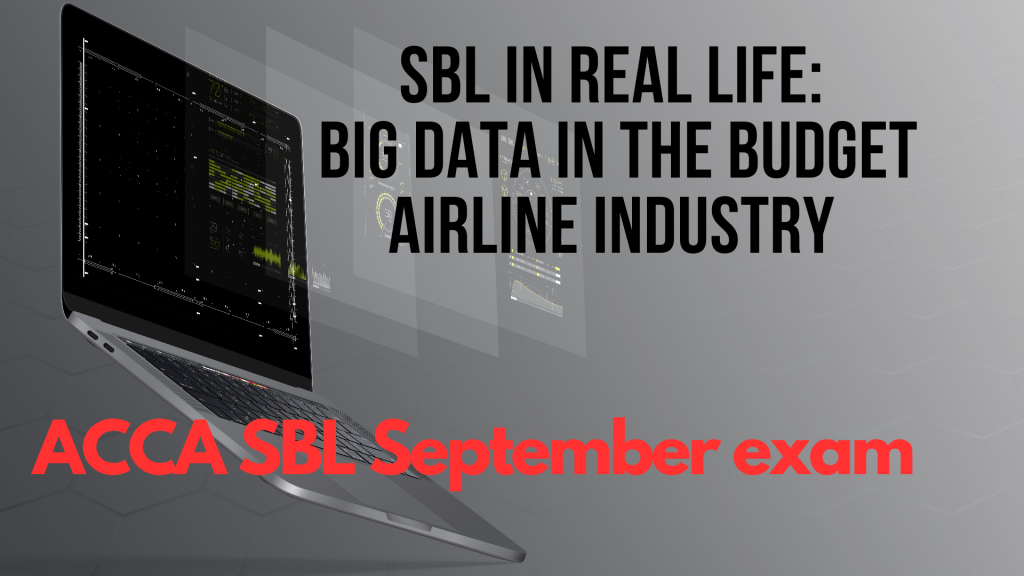
The September 2023 SBL case
study is based on the airline industry, so the examiner may draw some examples
of real-life scenarios when setting questions. The following article relates to
a critical topic in the SBL syllabus, “Big Data”. In the exam, you
don’t need to describe theories behind “Big Data” model but use the
concepts to generate ideas and paragraphs for the briefing paper or report.
I will be offering a
complimentary review of the Pre-Seen on September 2nd at 2pm UK time, which
will be 9pm Singapore time. It was sold out but I have just added extra slots.
If you are sitting the exam,
please sign up here
https://www.eventbrite.com/e/706213984037?aff=oddtdtcreator
ACCA SBL in real life: How is
“Big Data” used in the budget airline industry?
Big data is transforming the operations and strategies of
budget airlines, empowering them to optimize performance, enhance customer
satisfaction, and make data-driven decisions. Let’s explore specific examples
of how budget airlines can leverage big data across various aspects of their
business using the prescriptive, descriptive, and predictive analytics
approaches:
Prescriptive Analytics
Operational Efficiency and Aircraft Maintenance:
Example – Wizz Air: This European budget airline could
implement data analysis of aircraft sensor data and maintenance records to
predict maintenance needs accurately. By proactively addressing maintenance
issues, Wizz Air can reduce unexpected downtime and enhance operational efficiency.
Customer Experience Enhancement and Personalization:
Example – JetBlue: A US-based budget airline like JetBlue
could employ prescriptive analytics to analyze customer preferences and
behavior. By tailoring services and offers based on this data, JetBlue can
create a personalized travel experience that resonates with passengers and
fosters loyalty.
Descriptive Analytics:
Customer Experience Enhancement:
Example – easyJet: As a UK-based budget airline, easyJet
could monitor social media channels to gain real-time insights into customer
sentiment. By promptly addressing customer concerns and leveraging positive
feedback, easyJet can enhance its reputation and build stronger customer
relationships.
Example – Jetstar Airways: As a budget airline based in
Australia, Jetstar Airways could analyze competitor data to inform its market
positioning. By understanding competitor pricing, routes, and customer
satisfaction, Jetstar Airways can adjust its strategies to maintain a
competitive edge.
Predictive Analytics:
Demand Forecasting and Pricing Optimization:
Example – Ryanair: This Irish budget airline can analyze
historical booking patterns, flight routes, and seasonal trends to predict
future demand accurately. By using predictive analytics, Ryanair can adjust its
pricing strategies and flight schedules in real-time to maximize revenue and
minimize unsold seats.
Route Planning and Expansion:
Example – AirAsia: As a leading budget airline in Southeast
Asia, AirAsia can utilize predictive analytics to analyze passenger
preferences, regional demand, and profitability of potential routes. This
data-driven approach would help AirAsia identify lucrative new routes and
optimize existing ones to cater to specific travel trends.
Fuel Efficiency and Cost Savings:
Example – Southwest Airlines: As a prominent low-cost
carrier in the US, Southwest Airlines could leverage predictive analytics to
analyze flight data, weather conditions, and aircraft performance. By
optimizing flight paths and making real-time adjustments, the airline can
achieve substantial fuel savings and minimize operational costs.
Fraud Detection and Security:
Example – IndiGo: This Indian budget airline could utilize
predictive analytics to identify patterns of fraudulent activities such as
credit card fraud or ticket scalping. By implementing robust fraud detection
mechanisms, IndiGo can protect both its revenue and customers’ financial
information.
Conclusion:
By categorizing the applications of big data in budget
airlines under prescriptive, descriptive, and predictive analytics, we
highlight the diverse ways in which data-driven insights can enhance various
aspects of the airline industry. From operational efficiency and customer
experience to pricing strategies and security measures, each approach offers
unique benefits that contribute to the overall success and competitiveness of
budget airlines.
Copyright © 2023 martywindle.com